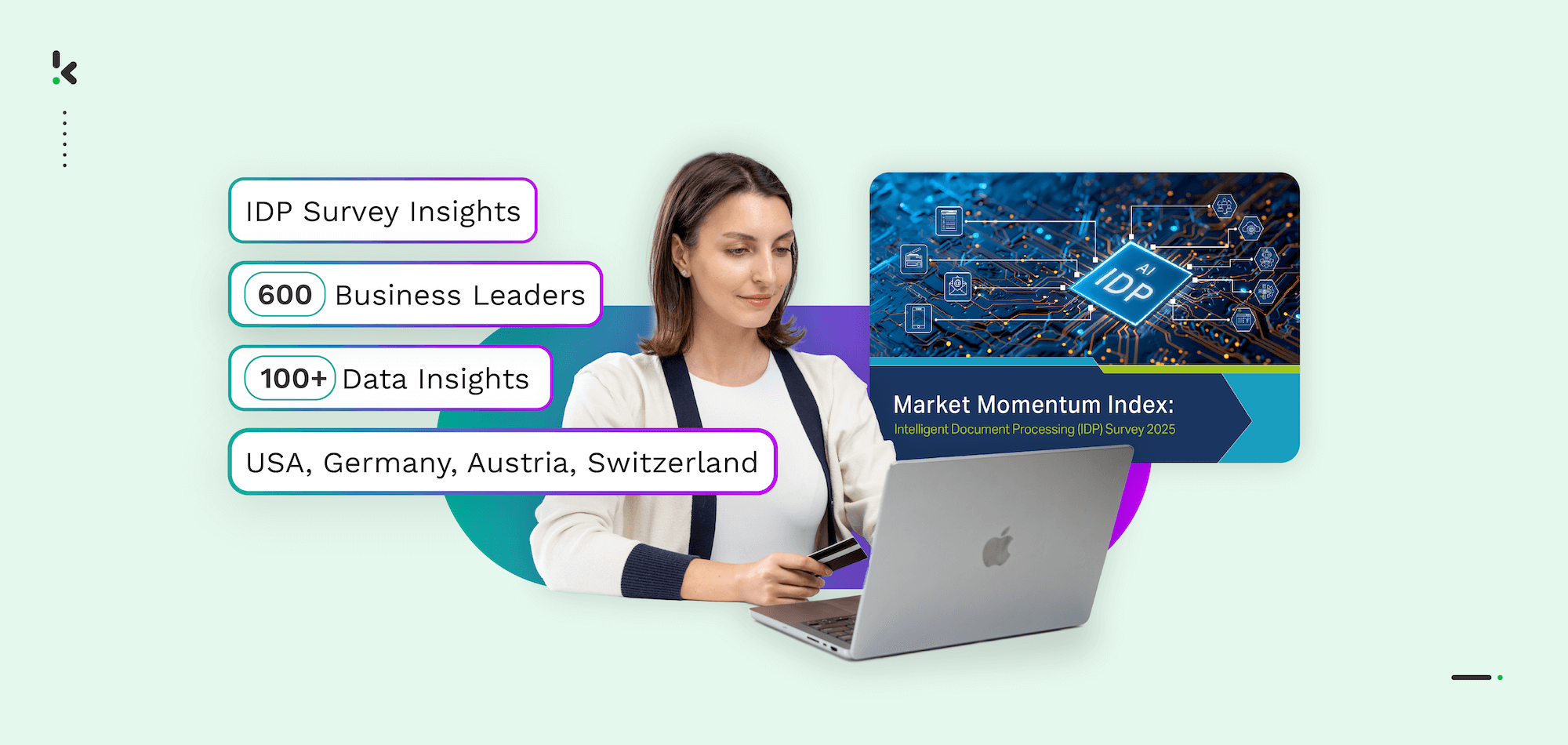

Documents are the backbone of business. Contracts, invoices, HR files, onboarding paperwork… they’re everywhere. But here’s the problem: legacy Intelligent Document Processing (IDP) systems were never built for the speed, scale, and complexity of today’s workflows.
That’s why more and more enterprises are moving to AI-powered IDP solutions. To better understand this shift, SER Group, AIIM, and Deep Analysis surveyed 600 business leaders across the United States, Germany, Austria, and Switzerland.
The findings reveal a market in transition:
- Two-thirds of enterprises are replacing outdated IDP systems.
- GenAI and LLMs are reshaping how vendors are evaluated.
- IDP is moving beyond the back office into front-office use cases like onboarding, contracts, and KYC.
- But challenges remain, from data security to integration and skills gaps.
In this article, we’ll unpack the key insights from the survey, highlight the opportunities and obstacles leaders face, and show how modern IDP can finally cut through document chaos.
Report Highlights: IDP Survey 2025
- 66% of enterprises are moving away from legacy IDP to modern AI-powered solutions.
- 78% already use AI in their document processing workflows.
- Adoption is expanding into front-office use cases like onboarding, contracts, and KYC — not just invoices.
- Top barriers: data security, integration challenges, and accuracy concerns.
- GenAI is changing buying behavior → US buyers rely on AI-powered research, while DACH leaders prefer proof-of-concepts and relationships.
- Paper is still alive: 61% of IDP projects involve paper documents, and faxes remain common in healthcare and government.
- Enterprises cite skills gaps, especially in process redesign and change management, as key adoption blockers.
- Success with IDP is defined by efficiency, scalability, and ROI, not by cutting headcount.
Bottom line: The market is moving fast. Enterprises know they can’t rely on outdated IDP. They need scalable, AI-driven solutions that go beyond back-office automation.
Why are so many enterprises moving to new IDP systems?
The survey results make one thing clear: legacy IDP tools can’t keep up with modern demands. Two-thirds of enterprises (66%) are replacing their existing systems, while another 65% are actively considering new IDP projects.
Why? Leaders pointed to three big pain points:
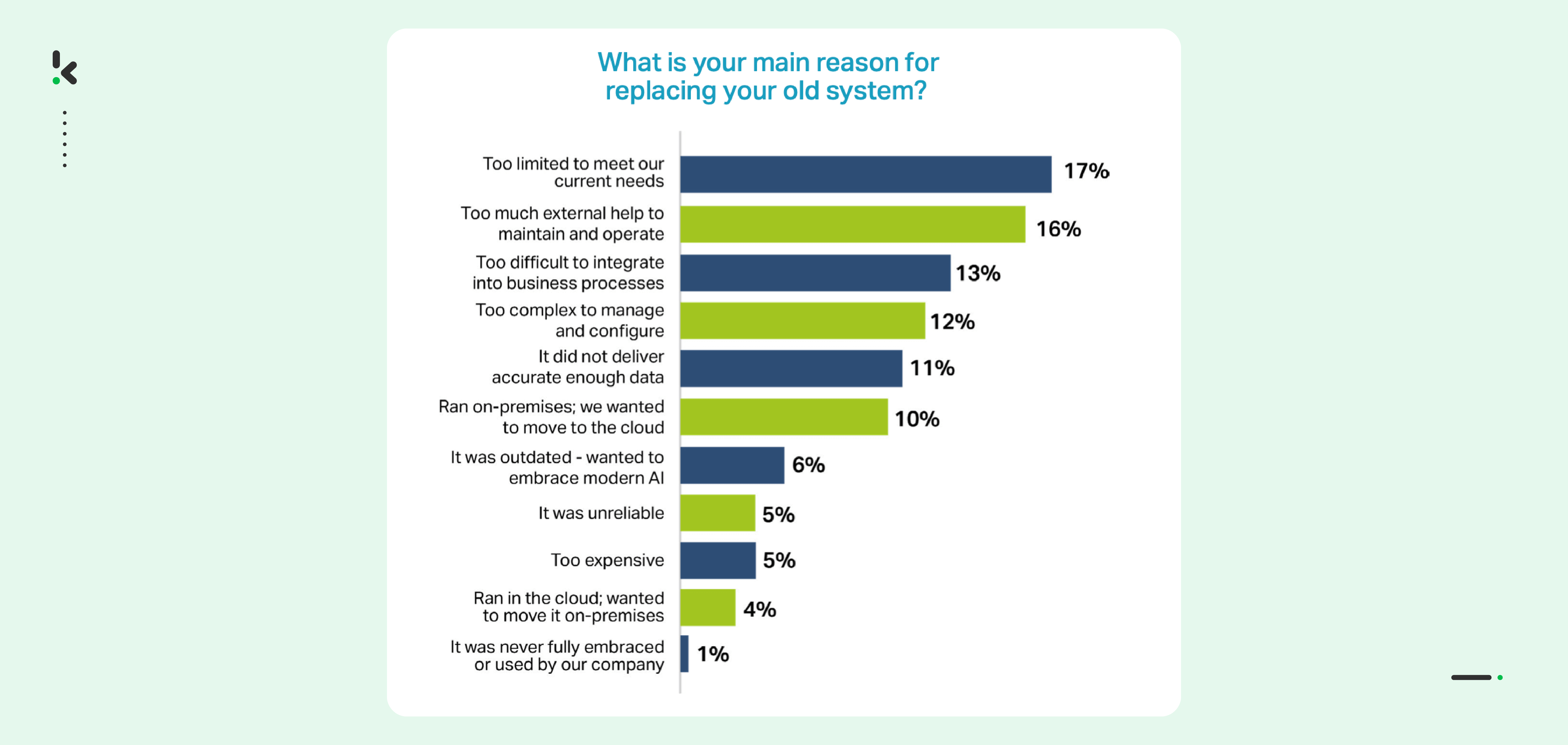

- Limited functionality → Legacy systems can’t handle today’s diverse workflows, from contracts to KYC.
- High reliance on external support → Too much consulting and customization slows adoption.
- Poor integration → Older tools don’t connect well with modern tech stacks.
At the same time, the market is being disrupted by Generative AI and LLMs. Startups and newer vendors are gaining ground quickly, while incumbents struggle to adapt.
For many enterprises, switching to modern, AI-powered IDP isn’t just about cost savings. It’s about staying competitive in a market where speed and accuracy are essential.
How widespread is AI adoption in document processing?
AI has moved beyond the pilot stage. According to the survey, 78% of enterprises already use AI in their document processing workflows. For many organizations, IDP is the easiest entry point into applied AI because it delivers quick, visible results.
Leaders highlight two main benefits:
- Efficiency gains → Automating routine tasks shortens cycle times and frees staff to focus on higher-value work.
- Improved accuracy → Modern IDP tools extract and classify data more reliably than legacy OCR systems.
Importantly, AI in IDP is no longer experimental. It has matured into a core operational capability, and the arrival of generative AI is expanding its role further. Enterprises are beginning to look beyond capture and extraction, toward enrichment, validation, and cross-system integration.
The takeaway: AI in document processing is not an emerging trend anymore. It’s a mainstream practice that sets the baseline for competitiveness.
What challenges hold back IDP adoption?
Even as adoption accelerates, enterprises face clear obstacles when rolling out IDP. The survey highlights three major blockers:
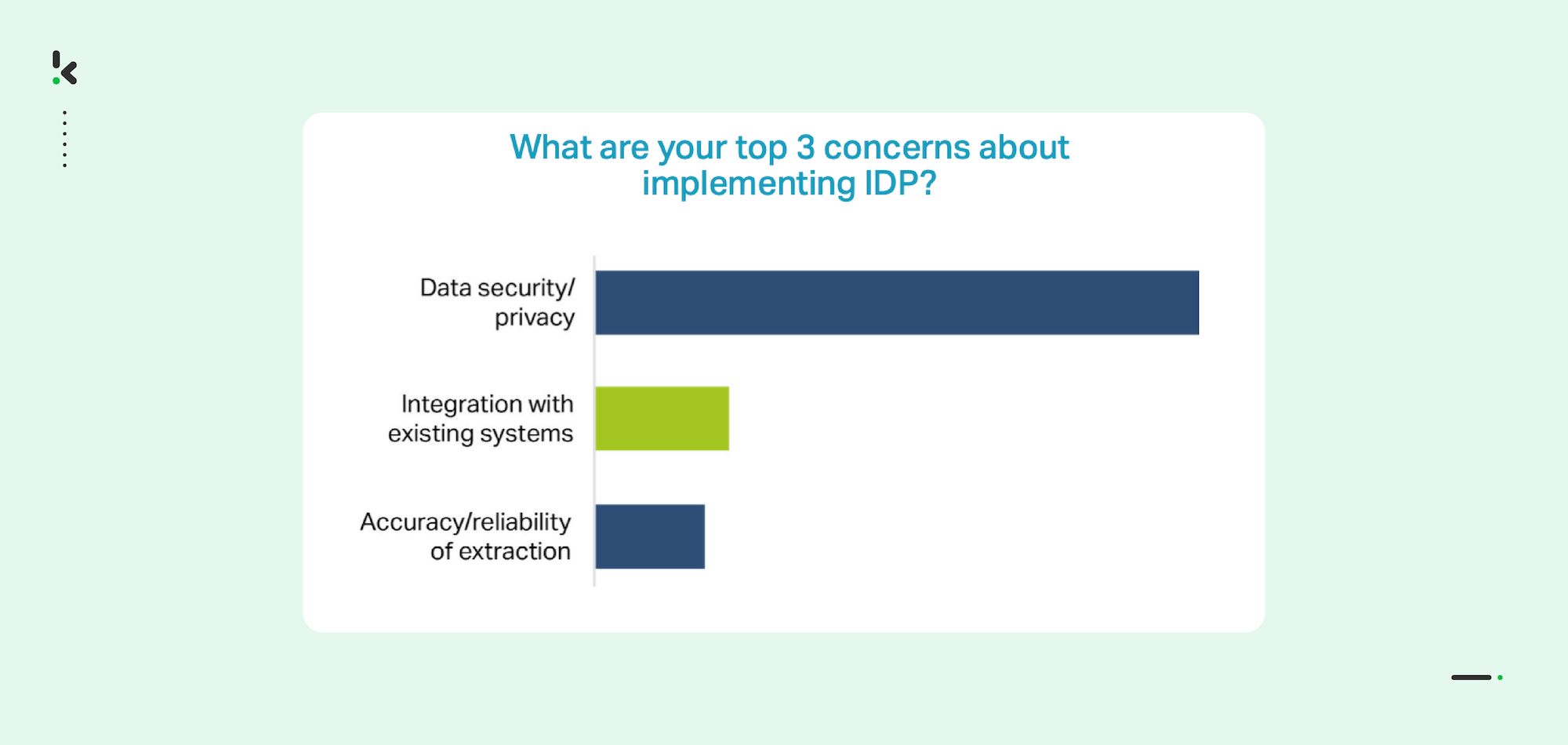

- Data security & privacy → Concerns about sensitive information remain the top barrier, especially in regulated industries.
- Integration complexity → Legacy systems don’t connect easily with modern IT stacks, creating delays and added costs.
- Accuracy & reliability → Some organizations still doubt whether AI-driven extraction can consistently meet compliance standards.
To address these challenges, enterprises are exploring deployment flexibility (private cloud or on-premise options) and agentic AI protocols such as MCP and A2A. Both approaches are designed to increase control, minimize risks, and build trust in automation.
In short, the appetite for IDP is strong, but companies need solutions that combine security, accuracy, and seamless integration before scaling further.
What new use cases are driving IDP growth?
For years, IDP was mostly associated with invoices and claims. The 2025 survey shows that’s changing quickly. Enterprises are now expanding into front-office processes, where automation directly impacts customer experience.
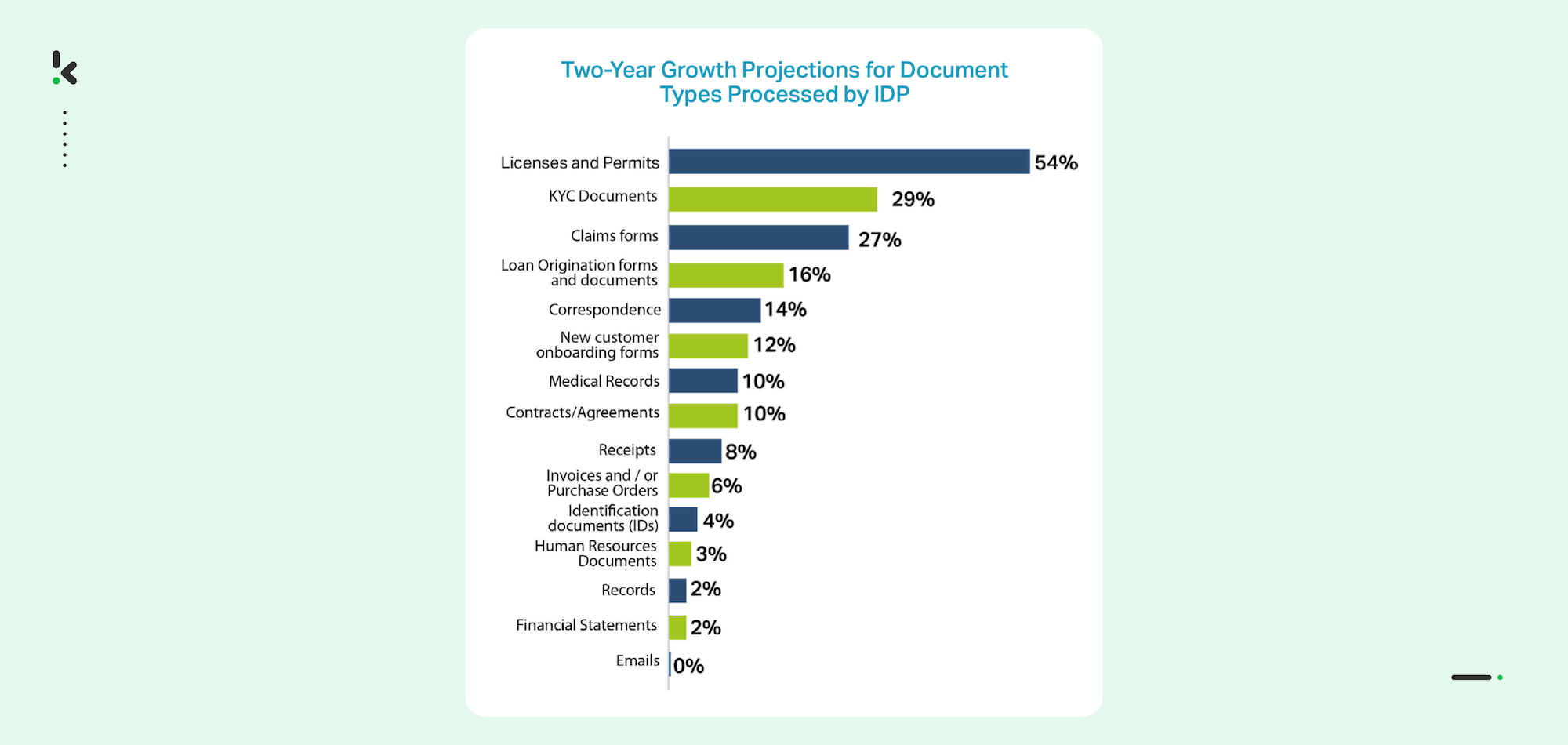

Key areas of growth include:
- Onboarding → Faster verification and smoother document handling for new customers or employees.
- Contracts → Automated extraction of key terms and obligations speeds up approvals and reduces risk.
- Licenses & permits → Streamlined compliance processes, especially in regulated industries.
- Know Your Customer (KYC) → Faster identity verification and reduced fraud.
One striking finding: 62% of IDP systems now involve external users. That means automation isn’t just an internal efficiency play — it’s becoming a customer-facing advantage.
The message is clear: IDP is moving out of the back office and into the spotlight, reshaping the way enterprises engage with clients, partners, and regulators.
How is GenAI changing the way buyers select vendors?
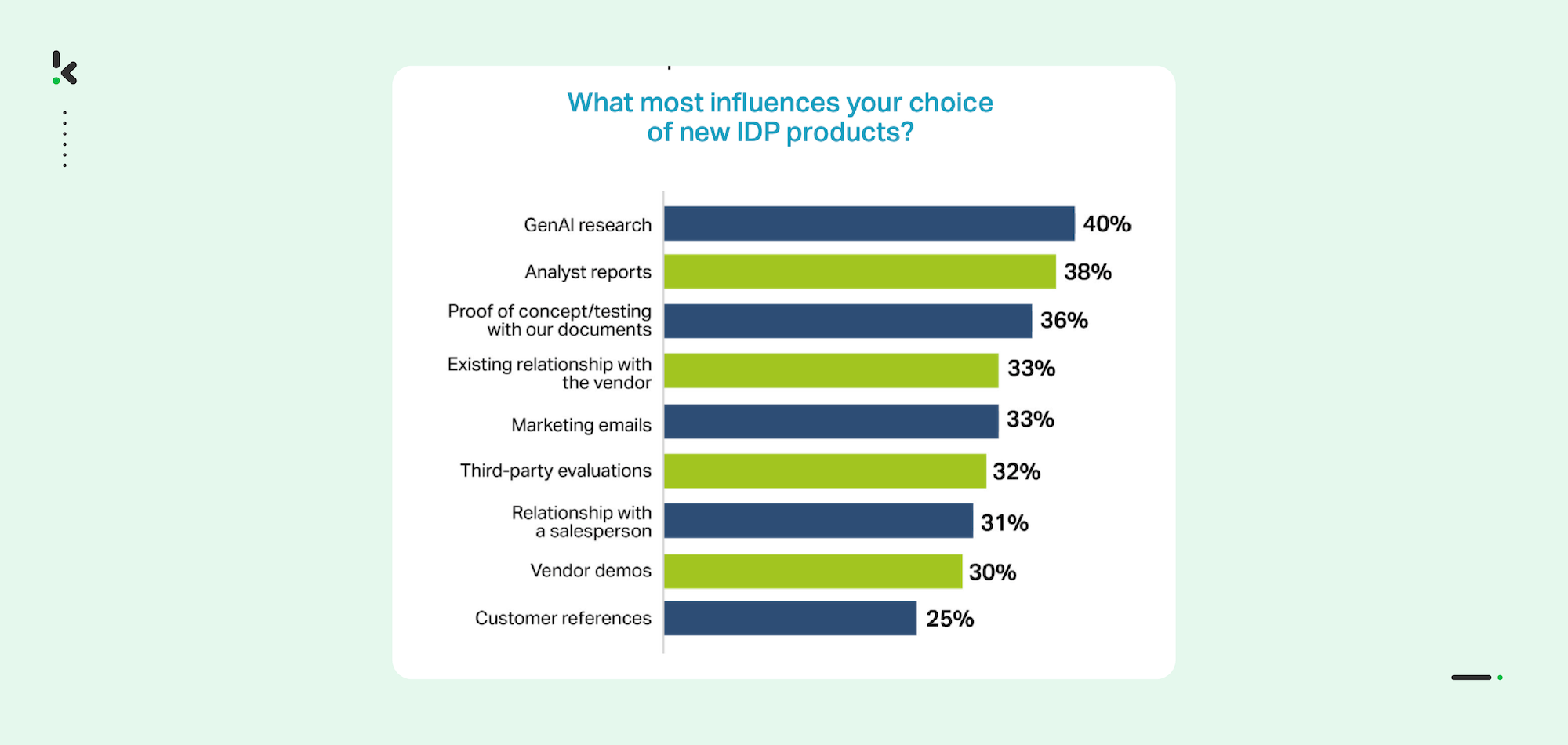

Generative AI is reshaping how enterprises evaluate their technology partners. The survey shows a clear split between regions:
- US enterprises → rely heavily on GenAI-powered research when evaluating vendors. Tools like ChatGPT and other LLMs are shaping early vendor shortlists.
- DACH enterprises (Germany, Austria, Switzerland) → still prefer hands-on methods such as proof-of-concepts, pilots, and personal relationships.
This split has big implications for vendors. In the US, visibility in AI-driven search results is critical, while in DACH, success still depends on demonstrating reliability and building trust face-to-face.
The key takeaway: vendors must adapt to regional buying behaviors. That means optimizing for both AI-powered discovery and traditional, relationship-driven evaluation.
Is paper finally dying in 2025?
Despite years of digitization, paper is still part of the picture. The survey found that 61% of IDP projects continue to involve paper documents. Even more surprising, 48% of enterprises expect paper volumes to increase in the near term.
Some sectors stand out:
- Healthcare and government → fax usage remains widespread, with 37% of enterprises still relying on it.
- DACH region → shows stronger expectations for a decline in paper compared to the US, where businesses predict more stability.
The persistence of paper highlights a reality many organizations face: digitization is advancing, but traditional channels won’t disappear overnight. For IDP providers, supporting both digital-first and paper-heavy processes remains essential.
What skills are enterprises missing for IDP success?
Technology alone doesn’t guarantee results. The survey highlights two major gaps holding back IDP projects:
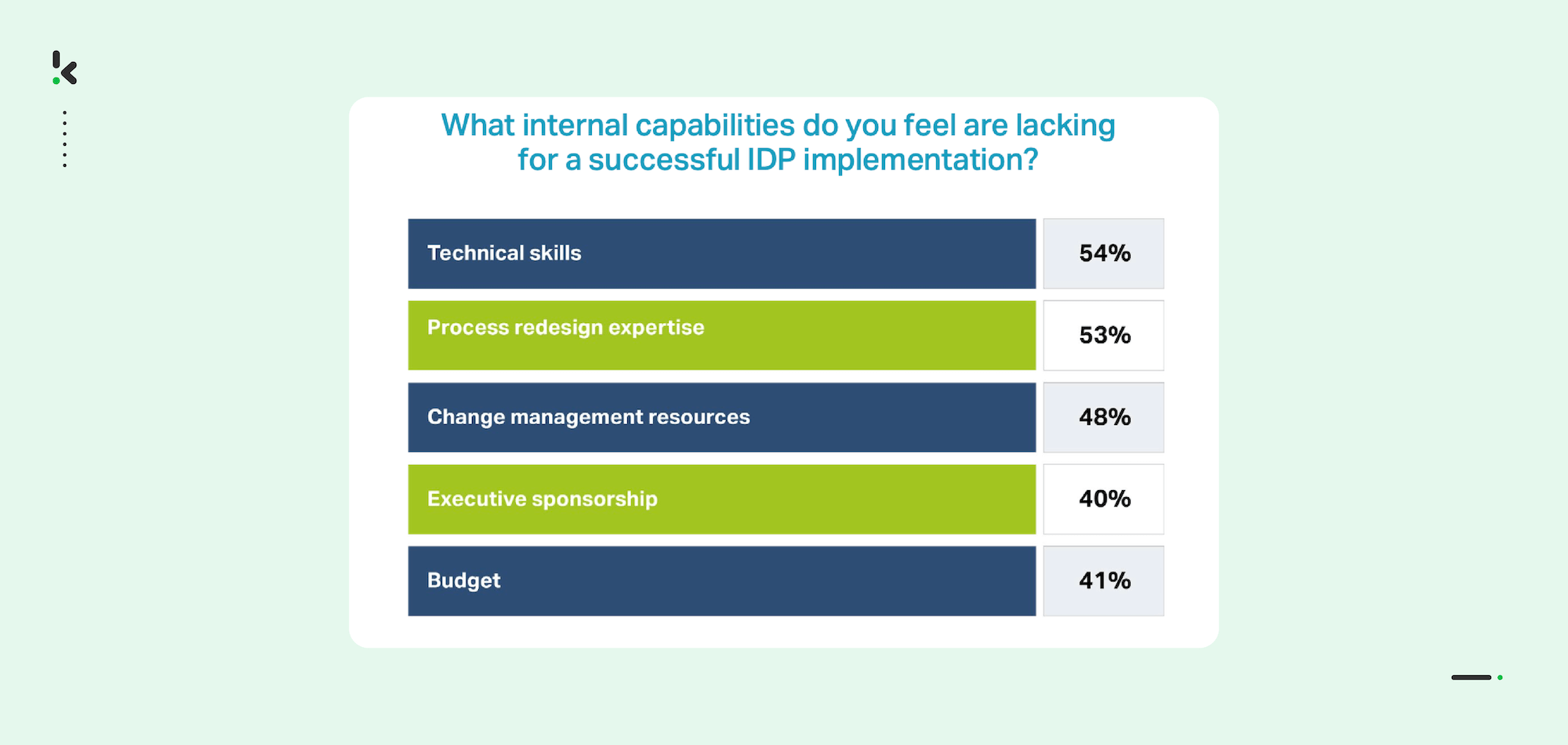

- Technical expertise → Many organizations lack the in-house knowledge to deploy, configure, and scale modern IDP platforms.
- Process redesign and change management → Even when the technology works, companies risk “digitizing old workflows” instead of rethinking them for automation.
These gaps leave enterprises vulnerable to stalled projects or underwhelming outcomes. Successful adoption requires more than a good vendor — it demands internal capability building and a willingness to rethink how work is done.
The lesson: without the right skills, IDP becomes just another tool. With them, it becomes a driver of transformation.
What does success with IDP look like?
When enterprises were asked how they define success with Intelligent Document Processing, the answers went beyond cost savings or headcount reduction. The top measures of value include:
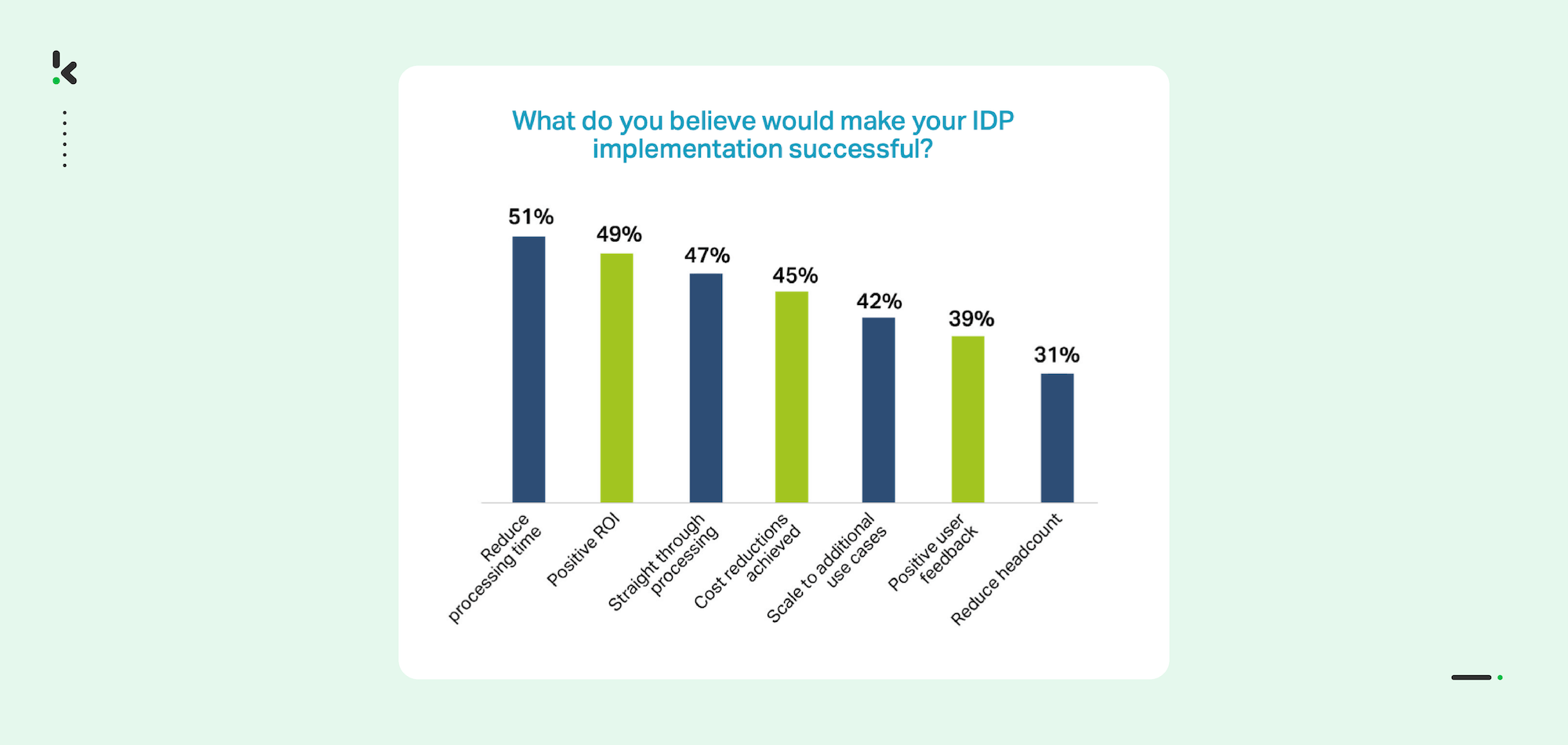

- Faster processing times → Shorter document cycles lead to quicker onboarding, approvals, and customer responses.
- Scalability → Systems that can handle more volume and complexity without breaking down.
- Return on investment → Clear financial benefits that justify adoption.
- Positive user feedback → Employees report less frustration and greater efficiency in their daily work.
Interestingly, reducing staff was rated as the lowest priority. For most enterprises, the goal of IDP is not to replace people but to free them for higher-value work and deliver a smoother experience for both employees and customers.
The message is clear: success with IDP is measured in speed, scalability, and satisfaction — not job cuts.
How do adoption trends differ by industry and region?
The survey shows that while IDP adoption is accelerating everywhere, the pace and priorities vary across industries and geographies.
By industry:
- Banking & Finance → leading adoption, driven by compliance-heavy processes like KYC and contracts.
- Healthcare & Government → slower progress due to reliance on paper and fax, but high potential for efficiency gains.
- Manufacturing & Energy → focus on scaling IDP to handle complex supply chain and compliance documentation.
By region:
- United States → enterprises rely heavily on GenAI research for vendor evaluation and expect paper usage to remain steady.
- DACH (Germany, Austria, Switzerland) → organizations are more traditional in vendor selection, but more optimistic about cutting paper volumes over time.
The conclusion: IDP adoption is universal, but the path looks different depending on industry pressures and regional work habits. Vendors and enterprises alike need to account for these differences to ensure success.
Key Takeaways for Business Leaders
The IDP Survey 2025 paints a clear picture of a market in transition. Enterprises are moving quickly to replace legacy systems, but adoption is shaped by new expectations and persistent challenges. Here’s what leaders should take away:
- Modernization is urgent → Two-thirds of enterprises are replacing outdated IDP tools that can’t handle today’s workflows.
- AI is mainstream → 78% of organizations already use AI in document processing, and the demand for generative AI features is accelerating.
- Use cases are expanding → IDP is no longer limited to invoices. It’s powering onboarding, contracts, and KYC — often involving external users.
- Barriers remain → Security, integration, and accuracy challenges slow adoption, alongside gaps in internal skills and change management.
- Success looks different → ROI, scalability, and faster processing are the top metrics, not job cuts.
- Regional and industry context matters → US enterprises lean on GenAI-driven vendor research, while DACH prioritizes trust and proof-of-concepts.
For business leaders, the message is clear: IDP is no longer optional. Enterprises that modernize today will gain efficiency, scalability, and a stronger competitive edge.
How Klippa + Doxis Help Enterprises Adopt Modern IDP
The survey shows what many leaders already know: legacy IDP tools can’t keep up. Modern enterprises need solutions that are accurate, scalable, secure, and flexible enough to handle both back-office and front-office workflows.
This is exactly where Klippa and SER Group’s Doxis platform come together.
- Klippa DocHorizon → AI-powered document automation built for speed and accuracy.
- Doxis Intelligent Content Automation → Enterprise-scale platform for compliance, integrations, and end-to-end information management.
By combining forces, Klippa + Doxis offer enterprises a future-ready IDP stack that:
- Automates complex workflows, from invoices and contracts to onboarding and KYC.
- Ensures compliance with global data security and privacy requirements.
- Integrates seamlessly with existing IT systems, reducing friction in adoption.
- Scales across regions and industries, from SMEs to multinational enterprises.
Together, Klippa and Doxis give organizations the power to cut through document chaos, close adoption gaps, and unlock real business value from IDP.
Book a demo to see how Klippa + Doxis can help your enterprise move beyond legacy IDP.
Frequently Asked Questions About Intelligent Document Processing (IDP)
IDP uses AI and machine learning to capture, classify, and extract information from documents of any format — PDFs, images, scans, or handwritten notes.
OCR recognizes text, but IDP goes further by applying AI for classification, validation, and integration into business workflows.
Older systems lack functionality, rely too much on external support, and don’t integrate well with modern IT stacks. That’s why two-thirds of enterprises are making the switch.
Beyond invoices, IDP is now widely used for onboarding, contracts, licenses, permits, and Know Your Customer (KYC) processes.
Security, integration, and accuracy are the most common barriers. Enterprises also report gaps in technical skills and change management.
GenAI is both a technology driver and a buying factor. US enterprises use it to research vendors, while DACH enterprises prefer proof-of-concepts and trusted relationships.
Klippa provides fast, accurate AI-powered document automation, while Doxis ensures compliance, scalability, and integration. Together, they deliver end-to-end IDP for modern enterprises.